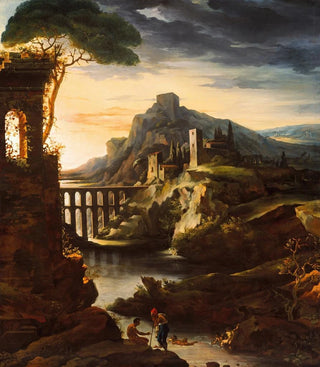Art print | Evening landscape with a aqueduct - Théodore Géricault


View from behind

Frame (optional)
Art print Paysage du soir avec un aqueduc by Théodore Géricault – Captivating introduction
The art print "Paysage du soir avec un aqueduc" by Théodore Géricault is a masterpiece that transports the viewer into a universe where nature and architecture meet in delicate harmony. Through this piece, Géricault invites us to contemplate a fleeting moment, that of a soothing twilight where warm colors blend into the sky, creating an atmosphere of serenity. This landscape, imbued with poetry, evokes feelings of calm and reflection, allowing the observer to escape into a world where time seems suspended. The magic of this work lies in its ability to capture the essence of a moment, while revealing the timeless beauty that resides in nature.
Style and uniqueness of the work
Géricault's style in "Paysage du soir avec un aqueduc" is distinguished by his mastery of light and color. The delicate nuances of orange, pink, and blue blend with remarkable subtlety, creating a striking contrast between the sky and terrestrial elements. The aqueduct, majestic and imposing, stands as a silent witness to this landscape, while adding an architectural dimension to the composition. The artist uses fluid and expressive brushstrokes, giving the painting a dynamic quality that captures the eye and invites exploration of every corner of the canvas. This work is a perfect example of how Géricault manages to marry realism and imagination, offering a vision that is both faithful and poetic of the world around him.
The artist and his influence
Théodore Géricault, an emblematic figure of French Romanticism, knew how to mark his era with his innovative approach and passion for depicting human emotions. Although he is famous for his historical works and powerful portraits, such as "The Raft of the Medusa," his exploration of landscape reflects his curiosity and desire to experiment with new genres. Géricault was influenced by the masters of the past, while seeking to break free from the academic conventions of his time. His work paved the way for

Matte finish

View from behind

Frame (optional)
Art print Paysage du soir avec un aqueduc by Théodore Géricault – Captivating introduction
The art print "Paysage du soir avec un aqueduc" by Théodore Géricault is a masterpiece that transports the viewer into a universe where nature and architecture meet in delicate harmony. Through this piece, Géricault invites us to contemplate a fleeting moment, that of a soothing twilight where warm colors blend into the sky, creating an atmosphere of serenity. This landscape, imbued with poetry, evokes feelings of calm and reflection, allowing the observer to escape into a world where time seems suspended. The magic of this work lies in its ability to capture the essence of a moment, while revealing the timeless beauty that resides in nature.
Style and uniqueness of the work
Géricault's style in "Paysage du soir avec un aqueduc" is distinguished by his mastery of light and color. The delicate nuances of orange, pink, and blue blend with remarkable subtlety, creating a striking contrast between the sky and terrestrial elements. The aqueduct, majestic and imposing, stands as a silent witness to this landscape, while adding an architectural dimension to the composition. The artist uses fluid and expressive brushstrokes, giving the painting a dynamic quality that captures the eye and invites exploration of every corner of the canvas. This work is a perfect example of how Géricault manages to marry realism and imagination, offering a vision that is both faithful and poetic of the world around him.
The artist and his influence
Théodore Géricault, an emblematic figure of French Romanticism, knew how to mark his era with his innovative approach and passion for depicting human emotions. Although he is famous for his historical works and powerful portraits, such as "The Raft of the Medusa," his exploration of landscape reflects his curiosity and desire to experiment with new genres. Géricault was influenced by the masters of the past, while seeking to break free from the academic conventions of his time. His work paved the way for






